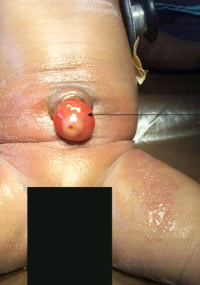Persistent Vitello-Intestinal Duct presenting as Prolapsed Loop of Ileum at the Umbilicus: A Case Report
Main Article Content
Abstract
Background: Vitelline duct or omphalomesenteric duct disorders occur because of persistence of the vitelline duct, which normally obliterates between the fifth and ninth weeks of intrauterine life. They occur in about two percent of the population and may remain asymptomatic throughout the entire life span; however, they can present sometimes with intra-abdominal complications or surgical conditions at the umbilical region. The omphalomesenteric duct connects the yolk sac to the midgut and usually obliterates at birth; however, its failure to obliterate may result to any of the following abdominal and umbilical surgical conditions such as Meckel’s diverticulum, patent vitelline duct, fibrous band, sinus tract, umbilical mass, enteric fistula with ileal intussusception prolapsing over the umbilicus.
Method: Presentation of a case report of persistent vitello- intestinal duct.
Downloads
Article Details
Section

This work is licensed under a Creative Commons Attribution-NonCommercial-ShareAlike 4.0 International License.
The Journal is owned, published and copyrighted by the Nigerian Medical Association, River state Branch. The copyright of papers published are vested in the journal and the publisher. In line with our open access policy and the Creative Commons Attribution License policy authors are allowed to share their work with an acknowledgement of the work's authorship and initial publication in this journal.
This is an open access journal which means that all content is freely available without charge to the user or his/her institution. Users are allowed to read, download, copy, distribute, print, search, or link to the full texts of the articles in this journal without asking prior permission from the publisher or the author.
The use of general descriptive names, trade names, trademarks, and so forth in this publication, even if not specifically identified, does not imply that these names are not protected by the relevant laws and regulations. While the advice and information in this journal are believed to be true and accurate on the date of its going to press, neither the authors, the editors, nor the publisher can accept any legal responsibility for any errors or omissions that may be made. The publisher makes no warranty, express or implied, with respect to the material contained herein.
TNHJ also supports open access archiving of articles published in the journal after three months of publication. Authors are permitted and encouraged to post their work online (e.g, in institutional repositories or on their website) within the stated period, as it can lead to productive exchanges, as well as earlier and greater citation of published work (See The Effect of Open Access). All requests for permission for open access archiving outside this period should be sent to the editor via email to editor@tnhjph.com.
How to Cite
References
Kadian YS, Verma A, Rattan KN, Kajal P. Vitello-intestinal duet anomalies in infancy. J Neonat Surg. 2016; 5:30.
Raicevic M, Filipovic I, Sindjic-Antunovic S. Hernia of the umbilical cord associated with a patent omphalomesenteric duct. J Postgrad Med. 2017; 63:58–9.
Singh, S., Pandey, A., Ahmed, I. et al. Prolapse of bowel via patent vitello intestinal duct—a rare occurrence. Hernia 2011; 15:567–569.
Jona JZ. Congenital hernia of the cord and associated patent omphalomesenteric duct: a frequent neonatal problem? Am J Perinatol. 1996; 13:223–6.
Mirza B, Saleem M. Hernia of umbilical cord with congenital short gut. J Neonat Surg. 2014; 3:26.
Kamii Y, Zaki Am, Honna T, Tsuchida Y. Spontaneous regression of patent omphalomesenteric duct from a fistula to Meckel’s diverticulum. J Pediatr Surgery 1992;27: 115-6.
Haas J, Achiron R, Barzilay E, Yinon Y, Bilik R, Gilboa Y. Umbilical cord hernias: prenatal diagnosis and natural history. J Ultrasound Med. 2011; 30:1629–32.
Vassy LE, Boles ET Jr. Iatrogenic ileal atresia secondary to clamping of an occult omphalocele. J Pediatr Surg. 1975; 10:797–800.
Elebute E A, Ransome-Kuti O. patent vitello intestinal duct with ileal prolapse. Arch. Surg 1965; 91:456-60.
Soutar SF, Douglas DM, Dennison W M. Patent vitello–intestinal duct: the risk of obstruction due to prolapse. Br J Surg 1958; 45:617-20.
Yamada T, Seiki Y, Ueda M, et al. Patent omphalomesenteric duct: a case report and review of Japanese literature. AsiaOceania J Obstet 1989; 15:229-36.
Hyman N, Leiko N S, Dolgin S. The curious umbilicus: clue to the cause of abdominal pain. JPediatrGastroenterolNutr. 1991; 13:90-1.
Molderez C M, Wouters K B,Bergmans G B, Michiels G K. Umbilical discharge: a review of 22 cases. ActaChirBelg 1995; 95:166-9.
Iwasaki M, Taira K, Kobayashi H, Saiga T. Umbilical cyst containing ectopic gastric mucosa originating from an omphalomesentric duct remnant. J Pediatr Surg. 2009; 44:2399-401.
Rajendra K.G. Management of Patent Vitellointestinal Duct in Infants. Ann Natl Acad Med Sci. 2021; 57:94-99.
Kotecha M, Bellah R, Pena AH, Jaimes C, Mattei P. Multimodality imaging manifestations of the Meckel diverticulum in children. Pediatr Radiol. 2012; 42:95-103.
Suleyman C, Seyithan O, Esra P, Cemile B, Elmas R.A and Serdar S. Vitelline duct pathologies in neonates. North Clin Istanb. 2018; 5:211-215.

